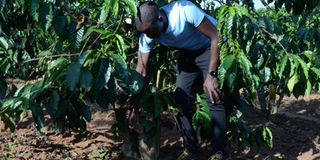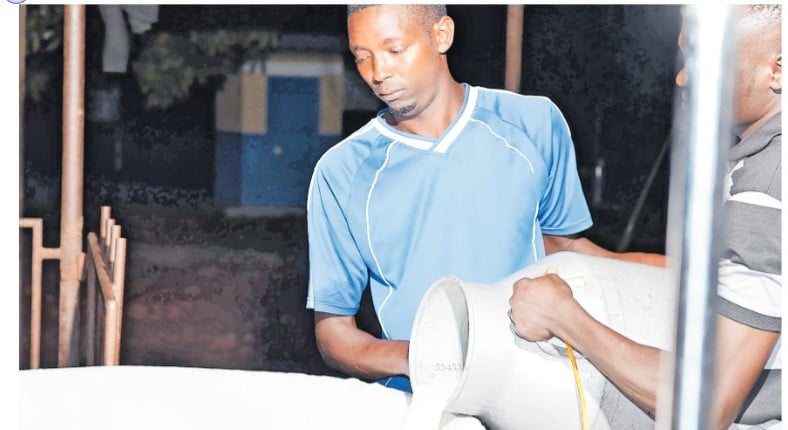Prime
Best practices for growing coffee

Ruyombo shows a half pruned coffee plant in Buikwe District. Photo by George Katongole
What you need to know:
- How a farmer manages his or her coffee plantation translates to the final aroma of the beverages, writes George Katongole.
- But getting the right cherries that meet the export market remain their core business and through their field officers, they monitor the implementation of good coffee growing practices.
Coffee remains Uganda’s main cash crop as the top foreign exchange earner. But much of what is offered to the market is mainly influenced by the farmers.
Before the hurdles of post-harvest handling, a farmer goes through a tedious process to bring the best coffee.
Agronomists are continuously devising means of getting the best out of coffee. Joseph Ruyombo, an agronomist at Ugacof Nkokonjeru field office in Buikwe District recommends the best practices farmers can adopt.
Ugacof is benefitting from the funding they have received from aBi Development to promote Robusta coffee growing in Buikwe District.
ABi funded the establishment of a wet processing plant in Nkokonjeru to add value to their coffee.
In 2018, Ugacof was consequently named winner of the 24th President Exporters’ Award for 2018.
But getting the right cherries that meet the export market remain their core business and through their field officers, they monitor the implementation of good coffee growing practices.
Early days
Ruyombo recommends the right planting conditions which include the right hole sizes of 2ft long by 2ft wide and 2ft deep. The best practice is heap the top soil on one side and bottom soil on another side before manure is added. Young plants are provided a temporary shade and water. The garden should be kept weed free with mulching an option.
Water bands
It is important to manage floodwater during the rainy season by establishing trenches in the garden. By keeping harvested water around the agricultural land infiltration and soil moisture are enhanced.
Ruyombo says that trenches should at least be 2ft in diameter and depth.
He notes that however, every after 10 feet, tie bands should be established to stop run off damaging the garden.
Tie bands are left undug. He says that the spacing is mainly determined by the slop with more frequent bands in hilly areas. Soil bands should be repaired after every rainy season.
Cover plants
Ruyombo stresses that coffee plants should always be healthy and providing some shade is necessary.
He says that a healthy coffee plant is one that can produce high quality seeds. This he adds, is attributed to plant genetics, the environment and applied farm management.
Ruyombo notes that a farmer may choose to manage shade trees especially in Robusta which can survive with a limited amount of sun.
Shade trees include albizia, avocado and mutuba. He recommends that about 25 shade trees need to be planted in an acre.
Desuckering
Ruyombo explains that desuckering helps to maintain a single stem and avoid competition from suckers.
He says that such secondary branches should be removed within 20cm of the main stem.
He says that they can be managed with a sharp object although his recommendation is the use of secateurs.
Pruning
Coffee becomes less productive as it ages. Therefore, pruning is a common way to stretch the lifespan of a coffee tree.
According to Ruyombo, a coffee plant’s cycle is about 32 years although productivity dwindles after seven years.
He says that the other option is re-planting but it takes longer time to re-establish the farm followed by about two years of no production.
He says there are two practices: single and multi-stemmed pruning. He recommends that pruning should be carried out at the end of the harvest season.
Generally, two-year-old secondary stems are found to be most productive, and this motivates coffee farmers to maximise the number of these within their plantations each year.
For trees that have grown tall, it makes it hard to reach the cherries and make picking less efficient. One must cut away any unproductive, damaged, unhealthy, or unnecessary branches and leaves using clean, angled tools.
Picking
Several farmers strip coffee yet Ruyombo recommends that selective harvesting is the best option.
Stripping harvests the coffee at once resulting in lots of varying maturation levels whereas selective picking takes care of only the ripest coffee cherries.
“For the best value farmers need to pick the red cherries. It is very tiresome but pays a lot. When you pick you only get the mature beans which is the best for cupping,” Ruyombo says.
Ruyombo states that strip harvest can lead to disuniform drying and lower quality product.
About aBi
Agricultural Business Initiative (aBi) was jointly founded by the Governments of Denmark and Uganda in 2010.
It is a social enterprise that channels development cooperation funding to agribusinesses and agricultural service providers in Uganda with the aim of building a competitive, profitable and sustainable agriculture and agribusiness sector in support of equitable wealth creation in Uganda. It currently comprises of aBi Development (formerly aBi Trust) and aBi Finance.
Since inception, aBi has channelled development funding as matching grants and Business Development Services to agricultural producers and agribusiness enterprises to enhance their management, production, productivity, value addition, income, profitability and employment.
This is done for six value chains: coffee, cereals, pulses, oil seeds, horticulture and dairy.
ABi has also supported enhancement of financial services for agribusiness by providing liquidity, de-risking instruments and technical assistance to Financial Institutions. ABi is funded by Denmark (DINIDA), Sweden (SIDA) and USA (USAID).
Stumping
Related to pruning, Ruyombo recommends stumping in a coffee farm. Stumping is usually performed when trees are old, infested, when their production or growth has declined drastically, or to make more space.
Ruyombo says that “you sometimes stump to just open up an area and then plant other crops, and then that young coffee tree begins to grow again.”
Pruning means removing a large part of the trunk and its stems, although some can be left to stimulate growth.
When stumping coffee trees, Ruyombo says one must be careful to provide enough nutrients for the tree to recover.
He says that the tree should not stumped at the extreme end. “Yu must leave at least two inches to avoid diseases.




